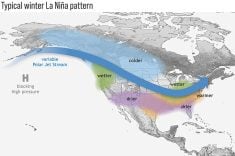Many Saskatchewan residents have an additional occupation this summer – cleaning up after Mother Nature.On the heels of extensive flooding in Maple Creek in June, last week’s torrential rain and flooding also affected people in Saskatoon and Yorkton.A powerful tornado packing winds of up to 300 km/h per hour ripped apart more than a dozen homes in the Raymore and Kawacatoose First Nation areas July 2.Officials from the Rural Municipality of Mount Hope were busy July 5 co-ordinating clean-up efforts and access to emergency help.But reeve Ernie Oblander said at least five farms had been severely damaged in addition to 15 homes on the First Nation. Some houses were completely destroyed while others lost their roofs or were moved from their foundations.No serious injuries were reported.Environment Canada estimated the tornado was at one point an F3 on the Fujita scale, indicating wind speed of about 300 km/h.Meteorologist Dan Kulak said that the tornado’s path was 45 to 50 kilometres long, beginning southwest of Govan, proceeding northeast between Semans and Raymore and then crossing both Highways 6 and 15 before slamming into Kawacatoose.Kulak said the most significant damage occurred near the junction of the highways and involved a Quonset.“The foundation as well as the pilings were pulled out of the ground,” he said.The wind necessary to do that pushed the storm to the F3 category. The damage at the reserve, where 72 people are now homeless, was caused by an F2 storm.Kulak said the examination of the damage also showed the tornado was about 500 metres wide in some areas and could have been on the ground for as long as an hour.Greg Marshall, president of the Agricultural Producers Association of Saskatchewan, has a farm near Semans that escaped damage.However, he toured the area and said he couldn’t believe the destruction.“There are trees torn up and bins and hopper bottoms scattered everywhere,” he said. “Machinery is twisted into knots. Some of the fields are just sandblasted.”To the east, near Yorkton, the fields are under water.Garry Liebrecht, reeve of the RM of Wallace, said the rain that swamped Yorkton’s downtown had to drain somewhere, and that is through the already saturated RM.Large lakes have formed where fields should be.“I’ve been farming since 1964 and this is the first year I can say I didn’t plant a full crop,” said the Rhein area farmer.The water flows through two main creeks in the RM as it winds its way to the Whitesand River. Liebrecht said the creeks are overflowing and culverts are out.“Barley is just turning yellow. The canola is only about eight inches tall and it’s blooming.”The RM of Wallace is among 72 municipalities to have declared disasters this year.The most recent storms are continuing a pattern of wet and unsettled conditions.Last week, Saskatchewan Liberal MP Ralph Goodale toured cropland in the Leroy, Wadena, Drake and Lanigan areas where excessive moisture prevented at least a quarter of the crop from being sown and will keep seeds that were planted from growing.“It’s going to demand an extraordinary response from government,” the former federal agriculture minister said after his tour with officials from APAS.He said existing support programs will not come close to providing adequate compensation and some creativity will be required to find ways to help the affected farmers.Farmers should be involved in that process, Goodale added.The premier, meanwhile, appointed a cabinet committee to co-ordinate the provincial response to the unusual flooding this year.Yogi Huyghebaert, minister of public safety, will chair the committee, which is intended to ensure a co-ordinated, long-term response to flooding victims and communities. It will also work with the federal government to make sure assistance flows smoothly.Meanwhile, high winds, rain and tornados also hit residents in southeastern Saskatchewan July 2.Bins were knocked over and houses damaged in Torquay, Benson, Carnduff, Carievale and Oxbow.
Read Also

Canadian Food Inspection Agency extends chronic wasting disease control program consultation deadline
Date extended for consultation period of changes to CWD program















